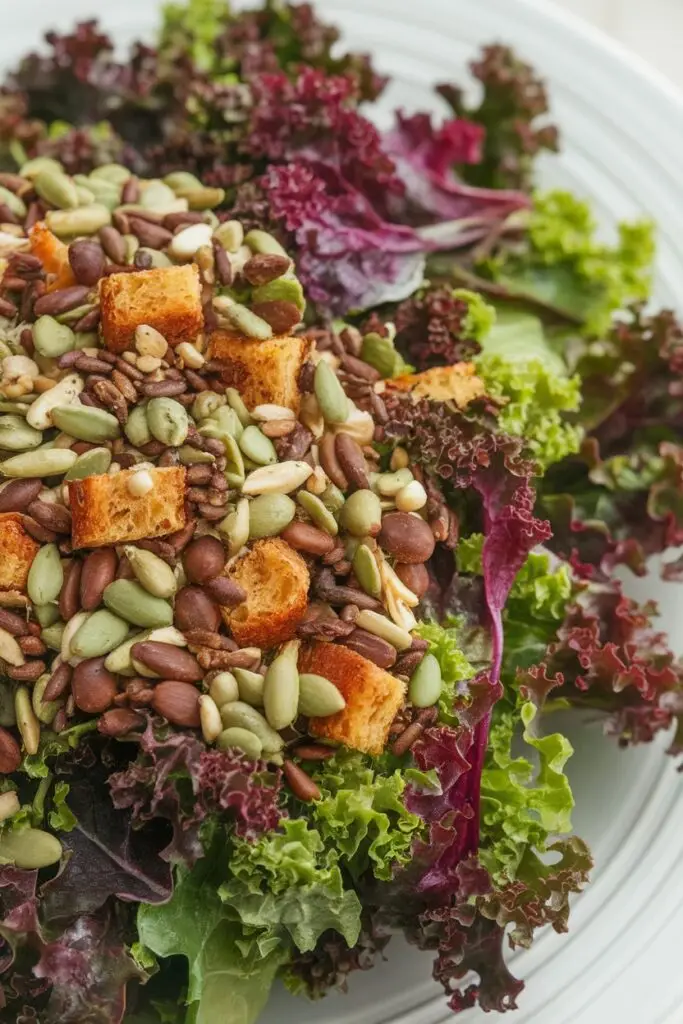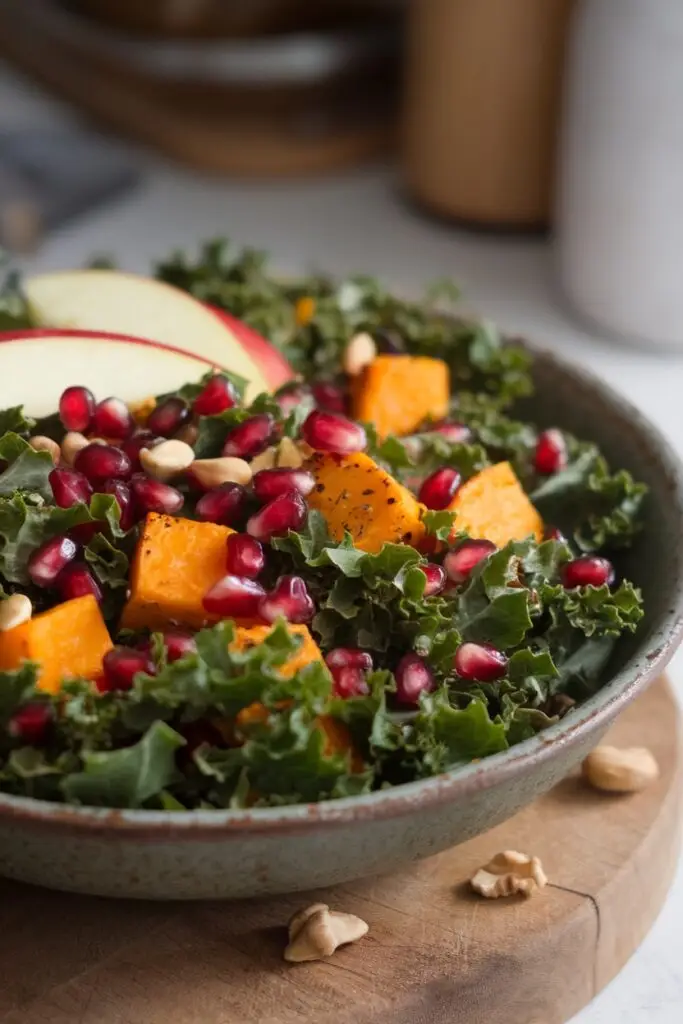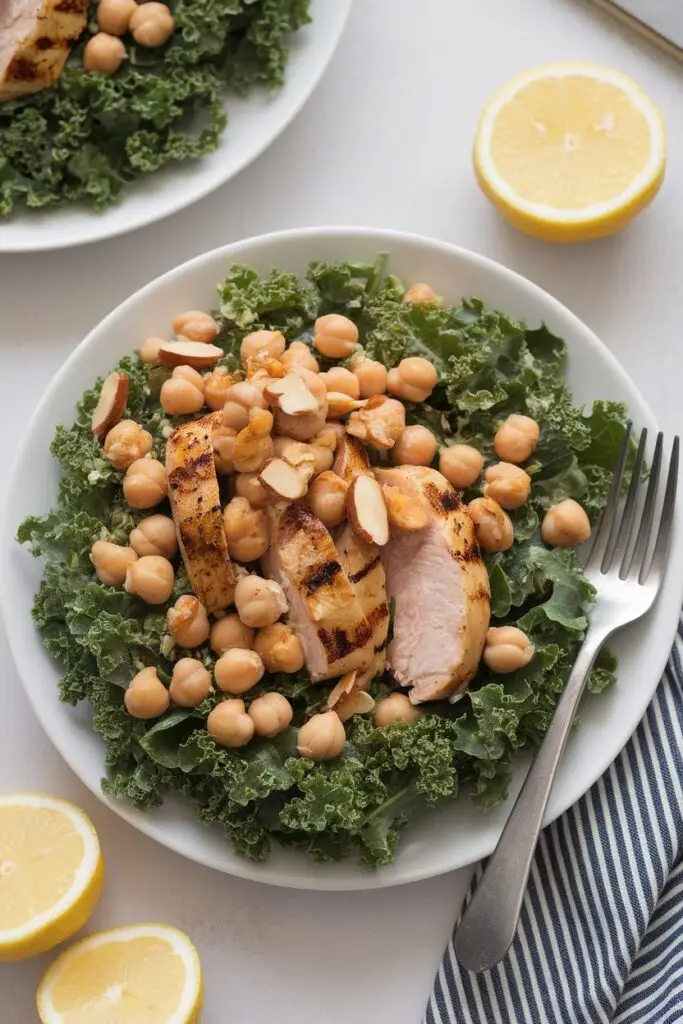
Kale salad recipe lovers, rejoice! If you’re looking to elevate your kale salad experience, this recipe is for you. We’ll not only share a delicious mix of ingredients but also an easy massage technique that transforms tough kale into a tender delight. Get ready to enjoy a refreshing, flavorful salad that’s perfect for any occasion!
Table of Contents
Kale Salad Recipe: Incorporating Crunchy Toppings for Ultimate Texture
This kale salad is not just a feast for the eyes; its crunchy toppings elevate it to a whole new level. With a delightful mix of seeds and croutons, it offers a satisfying contrast to the tender kale. The recipe is easy to whip up, making it a perfect choice for quick lunches or as a side dish for dinner.
Not only does this salad shine in flavor, but it also brings a variety of textures to your plate. The added crunch from toasted seeds and crisp croutons makes every bite interesting. Plus, you can customize the toppings based on what you have on hand, keeping it versatile and fun!

Ingredients
- 4 cups kale, chopped
- 1 cup mixed seeds (pumpkin, sunflower, and flax)
- 1 cup whole grain croutons
- 1/4 cup olive oil
- 2 tablespoons balsamic vinegar
- Salt and pepper to taste
- 1/4 cup grated parmesan cheese (optional)
Instructions
- Prepare the Kale: Rinse and dry the kale, then chop it into bite-sized pieces. Place it in a large bowl.
- Make the Dressing: In a small bowl, whisk together olive oil, balsamic vinegar, salt, and pepper.
- Toss the Salad: Pour the dressing over the kale and massage the leaves for about two minutes to soften them.
- Add Crunch: Sprinkle the mixed seeds and croutons on top of the kale.
- Finish: If desired, add grated parmesan cheese for an extra layer of flavor. Toss lightly and serve immediately.
Seasonal Additions to Elevate Your Salad
This kale salad is a delightful mix of flavors and textures, making it a standout dish for any meal. With the fresh crunch of kale and the sweetness of seasonal fruits, it’s both nourishing and satisfying.
Incorporating seasonal additions can really uplift this salad. Try adding roasted butternut squash for a warm, earthy flavor, or toss in pomegranate seeds for a burst of sweetness and color. Thinly sliced apples can add a crisp texture, while toasted nuts provide a satisfying crunch. These simple ingredients not only enhance the taste but also celebrate the bounty of the season!

Ingredients
- 1 bunch kale, stems removed, leaves chopped
- 1 cup roasted butternut squash, cubed
- 1 cup pomegranate seeds
- 1 apple, cored and thinly sliced
- 1/4 cup toasted pine nuts
- 2 tablespoons olive oil
- 1 tablespoon apple cider vinegar
- Salt and pepper to taste
Instructions
- Massage the kale: In a large bowl, drizzle olive oil and sprinkle salt over the chopped kale. Massage the leaves for about 2-3 minutes until they soften and become vibrant in color.
- Add the toppings: Gently mix in the roasted butternut squash, pomegranate seeds, apple slices, and toasted pine nuts.
- Dress the salad: Drizzle with apple cider vinegar and toss everything together until well combined. Adjust seasoning with salt and pepper as desired.
- Serve: Enjoy immediately or let it sit for a few minutes to allow the flavors to meld.
Flavorful Dressings for Your Perfect Kale Salad Recipe: Complementary Flavor Combinations
Kale salad can be a delightful addition to any meal, thanks to its robust texture and earthy flavor. The key to making kale truly shine lies in the dressing. A great dressing not only enhances the taste but also softens the kale, making it more enjoyable to eat. Plus, it’s simple to whip up your own dressings with just a few ingredients!
Consider using a zesty lemon vinaigrette, a creamy tahini dressing, or a tangy balsamic glaze. Each of these dressings brings out the unique flavors of kale while adding a layer of richness and depth. To make your salad even more enticing, toss in some nuts, seeds, or dried fruits for added crunch and sweetness. Enjoy a vibrant bowl of kale that packs a punch with every bite!

Ingredients
- 1 bunch of kale, stems removed and leaves chopped
- 1/4 cup olive oil
- 2 tablespoons lemon juice
- 1 tablespoon Dijon mustard
- 1 tablespoon honey or maple syrup
- Salt and pepper to taste
- 1/4 cup chopped nuts (e.g. almonds, walnuts)
- 1/4 cup dried cranberries or raisins
Instructions
- Prepare the Kale: In a large bowl, add the chopped kale. Drizzle with a bit of olive oil and massage the leaves for a few minutes until they soften.
- Make the Dressing: In a separate bowl, whisk together the olive oil, lemon juice, Dijon mustard, honey or maple syrup, salt, and pepper until well combined.
- Combine: Pour the dressing over the massaged kale and toss well to ensure all the leaves are coated.
- Add Mix-Ins: Sprinkle the nuts and dried fruits over the salad and give it another gentle toss.
- Serve: Enjoy immediately or let it sit for 10-15 minutes to allow the flavors to meld.
Pairing Your Kale Salad with Protein
This kale salad recipe is a refreshing and nutritious option that packs a flavorful punch. With its tender yet hearty leaves, it’s not only easy to make but also versatile enough to suit various tastes. The unique massage technique used on the kale helps soften its texture, making it more enjoyable to eat.
For a balanced meal, pairing your kale salad with protein enhances its nutritional value while adding richness to the dish. Options like grilled chicken, chickpeas, or toasted nuts not only make the salad more filling but also contribute layers of flavor.

Ingredients
- 4 cups kale, stemmed and chopped
- 1 cup cooked and sliced chicken breast (or chickpeas for a vegetarian option)
- 1 cup canned chickpeas, rinsed and drained
- 1/4 cup sliced almonds
- 1 lemon, juiced
- 2 tablespoons olive oil
- Salt and pepper to taste
Instructions
- Massage the Kale: In a large bowl, combine chopped kale with olive oil, lemon juice, salt, and pepper. Use your hands to massage the kale for about 2-3 minutes until it softens and darkens in color.
- Add Protein: Top the massaged kale with sliced chicken breast or chickpeas, along with the sliced almonds.
- Toss and Serve: Gently toss the salad to mix the ingredients together. Serve immediately or let it chill in the fridge for 20 minutes to let the flavors meld.
TRIVIA
Seasonal Kale Salad Mapping: The Year-Round Optimization Guide
While most kale salad recipes offer a single approach regardless of when you’re making them, the savvy kale enthusiast knows that this versatile green changes throughout the year. What many competitors won’t tell you is that kale’s flavor profile, texture, and nutritional content fluctuate seasonally, requiring different preparation techniques and pairings for optimal results.
Spring Kale Strategy:
In spring, young kale leaves contain higher concentrations of chlorophyll and lower levels of glucosinolates (the compounds responsible for bitterness). These tender spring leaves require gentler handling – massage for just 2-3 minutes with a lighter acid ratio (1:3 acid to oil instead of the standard 1:2). Pair spring kale with:
- Fresh herbs like mint and chervil that mirror kale’s springtime brightness
- Shaved fennel and watermelon radish for complementary crispness
- A honey-based vinaigrette that enhances kale’s natural spring sweetness
- Quick-pickled rhubarb for a seasonal tang that activates your palate
Summer Adaptation:
Summer kale develops thicker cell walls and more pronounced bitterness as a defense against heat and insects. Combat this by employing a dual-acid approach: begin with lemon juice for the massage, then finish with champagne vinegar in the final dressing. The sequential acid application breaks down fibrous structures more effectively than single-acid methods. Optimal summer pairings include:
- Stone fruits (particularly nectarines) whose enzymes further tenderize kale
- Fresh corn kernels for textural contrast and sweetness balance
- Burrata cheese, whose creamy richness counters summer kale’s intensity
- Toasted pine nuts activated with a touch of smoked salt
Fall Transformation:
Fall-harvested kale, particularly after the first frost, undergoes a fascinating transformation where starches convert to sugars (similar to what happens with Brussels sprouts). This is kale’s nutritional peak, with higher antioxidant levels than any other season. Maximize this by:
- Massaging with apple cider vinegar specifically (its malic acid compounds work synergistically with fall kale’s chemistry)
- Incorporating roasted root vegetables whose caramelization complements kale’s enhanced sweetness
- Adding fermented elements like miso in the dressing to create umami depth
- Including fresh pomegranate arils whose anthocyanins create a nutritional synergy with kale’s seasonal compounds
Winter Resilience:
Winter kale develops remarkable cold-hardiness through increased cell membrane phospholipids. This creates a more robust leaf that requires both mechanical and chemical tenderizing. The most effective winter technique is a “double massage” approach:
- First massage with kosher salt and let stand for 10 minutes
- Rinse thoroughly, then perform a second massage with acid and oil
- Allow a longer 30-minute rest period before final assembly
Winter kale pairs exceptionally well with:
- Aged hard cheeses whose enzymatic properties aid in breaking down kale’s winter toughness
- Preserved citrus (Meyer lemon or yuzu) that cuts through winter kale’s density
- Warm elements like toasted farro or quinoa whose heat partially wilts the greens
- Surprising sweet notes from dried persimmons or black mission figs
This seasonal mapping approach transforms kale from a one-note ingredient into a dynamic culinary canvas that evolves throughout the year. By adapting your technique, acid balance, and complementary ingredients to kale’s seasonal changes, you’ll create salads that consistently outperform standard recipes regardless of when you’re preparing them.
If you want to discover more hidden culinary gems around the world, check out this page.

